| Part of a series on |
| Indo-European topics |
|---|
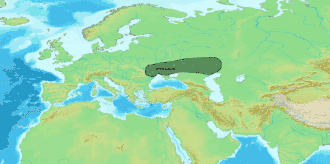 |
This is a list of early Slavic peoples reported in Late Antiquity and in the Middle Ages, that is, before the year AD 1500.
Ancestors
%252C_The_Horse%252C_The_Wheel_and_Language.jpg.webp)
- Proto-Indo-Europeans (Proto-Indo-European speakers)
- Proto-Balto-Slavs (common ancestors of Balts and Slavs) (Proto-Balto-Slavic speakers)
- Proto-Slavs (Proto-Slavic speakers)
- Proto-Balto-Slavs (common ancestors of Balts and Slavs) (Proto-Balto-Slavic speakers)
Antiquity
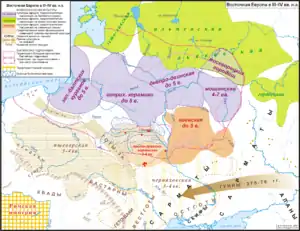

- Sporoi (also known as Vistula Veneti): A common ancestor of all Slavs, Proto-Slavs, and the West Slavs of the same name. It is hypothesized that Proto-Slavs had their origin in western Ukraine - west of the Dnieper, east of the Vistula, south of the Pripyat Marshes and north of the Carpathian Mountains and the Dniester, to the northwest of the Pontic Eurasian Steppes and south of the Baltic peoples, especially West Baltic peoples, with whom they have common ancestors, the Balto-Slavs.[1][2] Proto-Slavs are mainly associated with Zarubintsy culture[3][4][5] that had possible links to the ancient peoples of the Vistula basin (Przeworsk culture). Proto and Early Slavs, who were closely related to the Balts, were more influenced by the ancient Celts (La Tène culture) and by the Scythians and Sarmatians (Western Eurasian Steppe Iranian peoples from the northeast group who were nomads or seminomads).[6][7] According to Marija Gimbutas, the people named "Scythian Farmers", mentioned by Herodotus, were the Proto-Slavs or Early Slavs, who bordered and lived south of the Balts, and not Scythians.[8]
- Antes: Common ancestors of the East Slavs and most Eastern South Slavs. Also contributed to the West Slavs
- Veneti: Common ancestors of the West Slavs. Also contributed to the Western South Slavs and the East Slavs)
- Sclaveni: Ancestors of the Western South Slavs. Their name was adopted by the Byzantines in the 600s as a catch-all for all Balkan Slavs, regardless of origin
Middle Ages
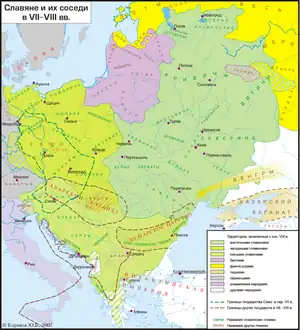
East Slavs
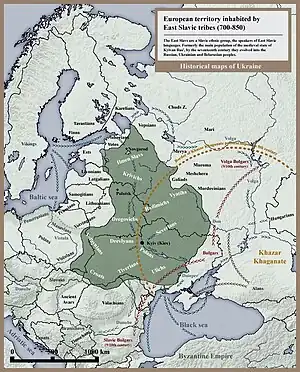
- Antes (common ancestors of the East Slavs; some were also the ancestors of part of West Slavs and South Slavs)
- Western-Northern groups
- Western Russian group / Western Ruthenian group / Western Old East Slavs ("Russians" or "Russian group" in the broad sense means Old East Slavic peoples, the common group from where modern ethnic groups or peoples of the Rusinians, Ukrainians, Belarusians and Russians descend and not only Russians in the narrow sense)
- Southwestern group (roughly in a large part of the hypothesized region of Proto-Slavs origin)
- Dulebes (Dulebi), ancestors of Ukrainians and Belarusians and part of Czechs. Assimilated into several East Slavic tribes or were the ancestors of them: the Volhynians, Drevlians, Polans, Dregoviches, and possibly Buzhans, eventually to become part of the Kievan Rus'.
- Buzhans / Bugans (Bugane > Buzhane; [g] > [ʒ]; zh = [ʒ]) (in the regions of the Southern Bug and Western Bug rivers)
- Southern Bug Buzhans (Southern Bug Slavs) (Buzhane), ancestors of Ukrainians and Russians[10][11]
- Western Bug Buzhans (Western Bug Slavs) / Volhynians (Volynyane), ancestors of Ukrainians and part of Czechs
- Dregoviches / Dregovichians (Dregovichi), same with Draguvites, ancestors of Belarusians
- Drevlyans (Drevlyane), ancestors of Ukrainians and Belarusians
- Polans (eastern) (Polyane), ancestors of Ukrainians, in Dnieper right (western) bank, Kyiv region.
- Buzhans / Bugans (Bugane > Buzhane; [g] > [ʒ]; zh = [ʒ]) (in the regions of the Southern Bug and Western Bug rivers)
- Teverians (Tivertsi / Tyvertsi) / Stadici / Stadichi (Stadychi)?,[12] ancestors of Ukrainians and part of Moldovans and Romanians
- Dulebes (Dulebi), ancestors of Ukrainians and Belarusians and part of Czechs. Assimilated into several East Slavic tribes or were the ancestors of them: the Volhynians, Drevlians, Polans, Dregoviches, and possibly Buzhans, eventually to become part of the Kievan Rus'.
- Khorvaty, in Prykarpattia and Zakarpattia, ancestors of Rusyns, Ukrainians, and Croats[13]
- Southern group
- Central group
- Radimichians / Radimichs (Radimichi), ancestors of Belarusians and part of Russians
- Severians (Severyane), ancestors of Ukrainians, Russians and part of Slavic Bulgarians
- Southwestern group (roughly in a large part of the hypothesized region of Proto-Slavs origin)
- Old Russian group / Northern Russian group / Northern Ruthenian group / Northern Old East Slavs
- Northeastern group (Krivichian-Vyatichian group) (Krivichians and Vyatichians had a relevant part in the formation of Proto-Russians)
- Krivichians (Krivichi), ancestors of Belarusians and Russians (Kievan Rus' Principalities roughly corresponded to older tribal lands)
- Polochans (Polochane) / Polotskian Krivichians, in Polotsk Land (Polotskaya Zemlya) (later Polotsk Principality), ancestors of Belarusians
- Pskovians / Pskovian Krivichians, in Pskov Land (Pskovskaya Zemlya), ancestors of Russians
- Smolenians / Smolenian Krivichians, in Smolensk Land (Smolenskaya Zemlya) (later Smolensk Principality), ancestors of Russians
- Tverians / Tverian Krivichians, in Tver Land (Tver'skaya Zemlya) (later Tver Principality), ancestors of Russians
- Zalessians / Zalessian Krivichians, in Zalessa Land or Zalesye (Zalesskaya Zemlya) / Opolyans / Opolyan Krivichians, in Opolye Land or Opolye (Opolskaya Zemlya) (later Rostov-Suzdal Principality or Vladimir-Suzdal Principality, that gradually evolved into the Grand Duchy of Moscow also called Muscovite Russia or Muscovite Rus') (this political entity is traditionally perceived as a cradle of the Great Russian language and Great Russian people, i.e. the Russians as a distinct Slavic people) (originally Moscow region was an enclave inhabited by a remnant of the Dniepr-Oka Baltic peoples, the Eastern Galindians or Goliad', which were conquered in the middle of 11th century by Rostov-Suzdal)
- Vyatichians (Vyatichi) also Oka Slavs, ancestors of Russians[14] (Kievan Rus' Principalities roughly corresponded to older tribal lands)
- Kozelians / Kozelian Vyatichians, in Kozelsk Land (roughly in today's Kozelsk town and Kaluga and Tula regions, later part of the Chernigov Principality by conquest)
- Ryazanians / Ryazanian Vyatichians, in Ryazan' Land (later Ryazan Principality or Murom-Ryazan)
- Krivichians (Krivichi), ancestors of Belarusians and Russians (Kievan Rus' Principalities roughly corresponded to older tribal lands)
- Northeastern group (Krivichian-Vyatichian group) (Krivichians and Vyatichians had a relevant part in the formation of Proto-Russians)
- Western Russian group / Western Ruthenian group / Western Old East Slavs ("Russians" or "Russian group" in the broad sense means Old East Slavic peoples, the common group from where modern ethnic groups or peoples of the Rusinians, Ukrainians, Belarusians and Russians descend and not only Russians in the narrow sense)
- Northwestern group (possible Northern Slavic group?) (they had a relevant part in the formation of Proto-Russians)
- Ilmen Slavs / Ilmen Slovenians (Slovene), also known as Novgorod Slovenes, Novgorod Slavs (Slovene), ancestors of Russians
- Bezhetians / Bezhetian Ilmen Slovenians (in Bezhetsk Land - Begetskaja Zemlja) (later part of the Novgorod Land - Novgorodskaja Zemlja, and the Novgorod Republic)
- Derevians / Derevian Ilmen Slovenians (in Dereva Land - Derevskaja Zemlja) (later part of the Novgorod Land - Novgorodskaja Zemlja, and the Novgorod Republic)
- Obonegians / Obonegian Ilmen Slovenians (in Obonego Land - Obonegskaja Zemlja) (later part of the Novgorod Land - Novgorodskaja Zemlja, and the Novgorod Republic)
- Shelonians / Shelonian Ilmen Slovenians (in Shelona Land - Shelonskaja Zemlja) (later part of the Novgorod Land - Novgorodskaja Zemlja, and the Novgorod Republic)
- Ilmen Slavs / Ilmen Slovenians (Slovene), also known as Novgorod Slovenes, Novgorod Slavs (Slovene), ancestors of Russians
- Western-Northern groups
West Slavs
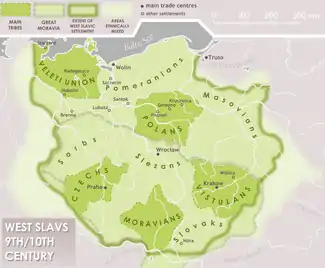
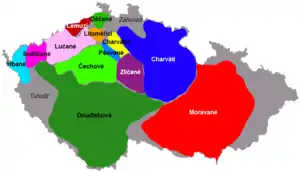
- Veneti / Wends Lechitic ancestors of West Slavs; some were also the ancestors of part of South Slavs
- Czech–Moravian-Slovak group
- Bohemians (Čechové), tribal confederation, in Bohemia, Czech Republic. Ancestors of Czechs
- Berunzani (a Slavic Bohemian tribe, Chekhove, of West Bohemia)
- Chekhove proper / Čechové (Bohemian Slavs proper), also known as Pragani (Fraganeo), the tribe that lived in the Prague and Central Bohemian regions
- Děčané, in Děčín region, Czech Republic
- Dudlebi (Doudlebi / Doudlebové) (Bohemian Dulebes), a group of Dulebes assimilated as a Slavic Bohemian or Czech tribe. (they lived in most of the southern half of Bohemia)
- Khébané (Chébané / Hbané)
- Khodove (Chodové) ("Walkers", "Patrollers" or "Rangers") (formed from recruited people originating in the western Carpathian Mountains) (in Tuhošt' Land)
- Litoměřici or Lutomerizi, in the Czech lands from the sixth century (they lived in the Litoměřice region)
- Luchane / Luchani / Lutsane (Lučané)
- Lemuzi
- Lupiglai
- Pshovane (Pšované) / Besunzane (Bežunčani)
- Sedlichane (Sedličané / Sedlčané)
- Volynyane, a group of Volhynians (Volhynian Buzhans) assimilated as a Slavic Bohemian or Czech tribe. Volhynians are ancestors of Poles, Czechs and modern day Ukrainians.
- White Serbs
- Zlicans (Zlitsans) / Zlichane (Zličané), in Bohemia (Czech). Ancestors of Czechs and possibly Poles.
- Moravians / Northern Merehani (Moravane), tribal confederation, in Záhorie (Slovakia) and Moravia. Ancestors of (modern) Moravians and part of the Slovaks. The Morava river of Moravia was in their lands. Ancestors of the South Moravians (Merehani), in Morava river valley, east Serbia, that migrated south of the Danube and were assimilated by South Slavs.
- Ganátsi / Hanátsi (Hanáci)
- Golasitsi / Holasitsi (Holasici)
- Gorátsi / Horátsi (Horáci)
- (Podyjští Moravané)
- Slovaks* (more appropriately Sloveni[15] for time period of this article), also called Nitran Slavs / Váh Slavs / Hungarian Slavs / Moravian Slovenes[16] / Sloväni / Slověniny), tribal confederation, in Slovakia and northern parts of Hungary, possibly western Hungary as well. Ancestors of Slovaks, mayhaps were part of broader Slavic group sharing the same name (notice similarities with the south Slavic Slovenians). Sometimes referred to as Slovieni,[17] although this word is generally incorrect, being a contracted term from 19th century.[18] Note: While today the male member of Slovak nation is called Slovák, the original name for such person would be approx. Sloven.[19] This is evident from the endonym of the country (Slovensko), and also the name for Slovak female (Slovenka) or language (slovenský jazyk). This change, purely linguistical, occurred starting in 14th century, applying the newer suffix -ák/-ak/-iak to the stem word Slov. This change most likely originated in neighbouring Bohemia, which is probably the reason why it never completely permeated Slovak language (compared to the Moravian region of Slovácko, so called Moravian Slovakia).
- Bohemians (Čechové), tribal confederation, in Bohemia, Czech Republic. Ancestors of Czechs
- Lechites (Lechitic group) Lechitic tribes are ancestors of Poles/Polish people, Lechia was the pre-Christian anme of Poland. Polish language as well as Sorbian, Polabian, Silesian, Lusatian, Pomeranian, Kashubians and many other dialects are part of the Lechitic group of languages.
- Polish tribes
- Lendians, in east Lesser Poland and Red Ruthenia (Poland and Ukraine). Ancestors of Poles
- Masovians, tribal confederation, in Mazovia, Poland. Ancestors of Poles
- Polans (western), tribal confederation, in Greater Poland, Poland. Ancestors of Poles.
- Silesians / Silezane / Slezane (Ślężanie) Lęchitic tribę, Poland. Ancestors of Poles.
- Besunzane / Bezunchane (Bieżuńczanie)
- Bobryane (Bobrzanie)
- Dyedoshane (Dziadoszanie) / Dadosesani
- Golensizi (Golęszyce)
- Lubushane (Lubuszanie)
- Lupiglaa (in today's Głubczyce region)
- Opolans / Opolini (Opolanie Lechitic tribe
- Silesians Slezane/(Ślężanie)
- Tryebovane (Trzebowianie)
- Vistulans, in Lesser Poland, tribal confederation, Poland. Ancestors of Poles
- Pomeranians, tribal confederation, in Pomerania, Lechitic tribes living at the Baltic Sea regions. Ancestors of Poles, Kashubians, Slovincians, modern-day Germans.
- Goplans, in Kuyavian-Pomeranian, Poland. Ancestors of Poles
- Kashubians, in Pomeranian Voivodeship, Poland
- Prissani / Pyritzans (Pyrzyczanie), in Pomerania, Poland. Ancestors of Poles
- Slovincians, a West Slavic tribe that lived between lakes Gardno and Łebsko near Słupsk in Pomerania, ancestors of Poles.
- Wolinians / Uelunzani, on Wolin island, Pomerania, Poland. Ancestors of Poles
- Wends also spelled as Wenedi, Veneti, Vendi, Vindi, Vinden
- Polabians Lechitic tribe
- Veleti (Wilzi) (Northern Polabians), Lechitic tribes in Mecklenburg-Vorpommern, modern-day Germany.
- Lutici, Lechitic tribal confederation, northeastern region of modern-day Germany.
- Bethenici (Bethenzi or Bechelenzi)
- Doshane
- Lutici
- Circipane, in Mecklenburg-Vorpommern, modrn-day Germany.
- Kessinians, in Mecklenburg-Vorpommern
- Redarians, ncstrors of Poles
- Tollensians, in Mecklenburg-Vorpommern, ancestors of Poles and some Germans
- Hevelli (Havolane), in Brandenburg, by river Havel, anctstors of Poles, Swiss and some Germans
- Morizani / Morichane
- Rani / Rujani, on Lechitic tribes on Rugia/Rügen island.
- Sprevane, by river Spree.
- Stodorane (Lutici Stodorane)
- Ukrani, in Uckermark and Vorpommern-Greifswald
- Obotrites / Reragi (Northern Polabians)
- Belesem / Byelozem = "White Earth" or "White Earth Tribe", they lived scattered in Oster Walde / Osterwalde - "Eastern Woods" in the Old Mainland Saxon view, west banks of the Elbe river
- Drevani = "Wood" or "Wood Tribe", they lived scattered in Oster Walde / Osterwalde - "Eastern Woods" in the Old Mainland Saxon view, west banks of the Elbe river) (Osterwalde and Luneburg Heath also matched the land where the Langobards lived for a time before migrating towards South) (mostly in today's Lower Saxony, in the Hanoverian Wendland, Lechitic tribes in modern -day Germany)
- Linones, in the region around Lenzen.
- Lipani, tribe that lived scattered in the west banks of the Elbe river
- Obotrites proper / Northern Obotrites (Wismar Bay to Lake Schwerin).
- Polabians proper, in modern-day eastern Schleswig-Holstein area.
- Travjane east of the Trave.
- Wagri / Wagrians (the eastern Holstein as part of Saxony).
- Warnabi / Warnower in (the upper Warnow and Mildenitz).
- Lutici, Lechitic tribal confederation, northeastern region of modern-day Germany.
- Polabian White Serbs / Boiki (Southern Polabians), in Saxony and Lower Lusatia. Ancestors of Poles, and Sorbs, and part of the tribal groups that migrated towards southeast and south of the Danube are the ancestors of Serbs.
- Polabian Serbs (Elbe Serbs)
- Sorbs / Old Sorbs (Srbove), tribal confederation, roughly in Southern Brandenburg, East Saxony-Anhalt (east of the Saale river) and Upper Saxony, roughly in the east of the Middle Elbe river basin.
- Khutitsi
- Lusatians-Milceni
- Lusatians, in Lower Lusatia. Ancestors of Sorbs (Modern Sorbs) in Lower Lusatia.
- Milchane (Milčané) / Milceni / Milzeni, in Upper Lusatia, and in an area of far north Bohemia. Ancestors of Sorbs (Modern Sorbs) in Upper Lusatia.
- Moinwinidi
- Nishane
- Nizitsi
- Polabian Serbs proper (Sorbs Serbs or Srbi), they gave the name to the tribal confederation (Srbove).
- White Croats, originally in Southern Poland by the 5th c. migrated to the Southern Europe, ancestors of Croats.
- Sorbs / Old Sorbs (Srbove), tribal confederation, roughly in Southern Brandenburg, East Saxony-Anhalt (east of the Saale river) and Upper Saxony, roughly in the east of the Middle Elbe river basin.
- Polabian Serbs (Elbe Serbs)
- Veleti (Wilzi) (Northern Polabians), Lechitic tribes in Mecklenburg-Vorpommern, modern-day Germany.
- Polish tribes
- Czech–Moravian-Slovak group
South Slavs

South Slavic tribes descend mainly from two Slavic tribal confederations, Sclaveni and Antes. To reach the Balkans, the two groups took two different paths. While the Sclaveni came from Central Europe north of the Danube and migrated south around the eastern edges of the Alps and across the western part of the Pannonian Plain, the Antes came from the steppe between the Dniester and the Dnieper, penetrating into the Balkans throuhgh Transylvania or, alternatively, the mouth of the Danube.[20]
A number of historians have attributed the early split between Eastern and Western South Slavs to the different origins of Sclaveni and Antes.[21] While Western South Slavs were closely linked to the Western Slavic Veneti, Eastern South Slavs originated from the Eastern Slavic Antes. This is confirmed by both historical records and the duplication of tribal names between West Slavs and Western South Slavs and East Slavs and Eastern South Slavs, respectively. For example, the Polabian White Serb confederation is generally thought to be the ancestor of both Western Slavic Sorbs and South Slavic Serbs, while the Dunabian Abodriti, also known as Praedenecenti, are generally associated with the Polabian Obotrites.[22]
The same is true for Antes and Eastern South Slavs. For example, part of the East Slavic Severians are known to have migrated to present-day northeastern Bulgaria, becoming foederati of the First Bulgarian Empire under the name Severi, while some Pripyat Dregoviches are assumed to have migrated to the valley of the Vardar, establishing themselves as the Drougoubitai.[23] The Seven Slavic tribes are also hypothesized to be Antes hailing from the lands of modern Ukraine, but missing records of their tribal names makes the hypothesis unverifiable.
Therefore, it has been suggested that the ancestors of medieval Serbs and Croatians were the Sclaveni, wereas the progenitors of the Bulgarian Slavs were the Antes.[24] Nevertheless, there must have been substantial overlap between Sclaveni and Antes, especially in contact zones. For example, the exact origin of White Croats is still shrouded in mystery. Some scholars consider them be an Antes tribal polity that migrated to Galicia in the 3rd–4th century,[25][26][27] while others regard them as early Sclaveni or as a mixture of both Antes and Sclaveni.[28]
Nevertheless, South Slavs over time evolved into a new Slavic ethnolinguistic group. This phenomenon was accentuated by the Bavarian expansion east (as an element in the Ostsiedlung) and by the Magyar settlement and expansion in the Pannonian Plain, which severed the contiguous land or territory between West and South Slavs (in the Middle Danube river basin) and contact between both of them, contributing to greater differentiation.
- Sclaveni / Slavini (common ancestors of most Western South Slavs)
- West South Slavic group
- Bošnjani, inhabited central parts of early medieval Bosnia, between the rivers of Upper Neretva on the south, Middle Bosna and the Krivaja (Bosna) on the north, Upper Drina on the east and Upper Vrbas on the west.[29] Ancestors of Bosniaks and Bosnians. Theories of them being descended from the Buzhans exist.[30]
- Braničevci / Braniches, in eastern Serbia
- Carantanians / Carniolan Slavs / Old Slovenes / Southern Slovene (Sloventsi), tribal confederation, in Austria and Slovenia. Ancestors of Slovenes (particularly Carinthian Slovenes). They descend in part from Nitran Slavs (Northern Slovenes) that were also partial ancestors of modern Slovaks.
- Dudleipa (may have been a branch of the Dulebes)
- Duliebi (may have been a branch of the Dulebes)
- Stodorane (Caranthanian Stodorane)
- Susili
- Docleani / Diokletlians, in southern Montenegro (see also Tribes of Montenegro)
- Guduscani, in Lika, Croatia
- Kanalites, in southern Dalmatia
- Merehani / Southern Merehani / Southern Moravians (Moravci / Moravtsi), in (South) Morava river, eastern Serbia. They descend from Moravian / Merehani tribal groups that migrated south of the Danube and over time differentiate themselves and were assimilated into South Slavs.
- Narentines / Neretvians, in southern Dalmatia
- Pannonian Slavs, in west Pannonian Plain, west of the Danube river, roughly in today's west Hungary. They were assimilated by Magyars after they settled in Hungary.
- Pannonian Dulebes
- Sava Slavs, roughly in the plain between the Sava and Mura rivers. Ancestors of part of Croats.
- Praedenecenti / Eastern Abodriti / Eastern Obotrites, in Banat. They descend from Abodriti / Obotrites tribal groups that migrated south of the Danube and over time differentiate themselves and were assimilated into South Slavs.
- Timočani, in eastern Serbia
- Travunians / Terbunians, in Herzegovina and western Montenegro
- White Croats, in Western Ukraine, Lesser Poland and Bohemia, ancestors of Croats
- White Serbs / Sorbs, in Lower Lusatia, Germany. Ancestors of Sorbs and Serbs
- Zachumliani / Zachlumians, in southern Dalmatia
- West South Slavic group
- Antes (common ancestors of most Eastern South Slavs)
- East South Slavic group
- Berziti / Bersites, in Ohrid, North Macedonia
- Drougoubitai / Draguvites, in North Macedonia and Greek Macedonia
- Moratsi, or Marvatsi, in the western Rhodopes, along the Mesta river and around Dospat
- Milcovci / Miltsovtsi
- Seven Slavic tribes (or Seven Slavic Clans) (Heptaradici / Eptaradici - "Seven Roots"?), tribal confederation, in northern Bulgaria and Southern Romania that formed the basis of the Slavic Bulgarians (after later being conquered by the Turkic origin Bulgars that formed much of the Aristocracy and led to the name change of the people and language)
- Unknown tribes (unknown names)
- Severians, in Dobrudja, / Severes / Severi (Balkan Severians), northeast Bulgaria and Southeastern Romania, the Severians were an East Slavic tribe, part of the tribal groups that migrated southward and southwestward and formed a union with the Seven Slavic tribes (to form the Slavic Bulgarians) and over time differentiate themselves and were assimilated into South Slavs.
- Smolyani, in the Central and Western Rhodopes, the Mesta valley and the adjoining areas of northern Greece. They revolted against Byzantine rule in 837 and after receiving military aid by Khan Presian I of Bulgaria, their territory was annexed by the First Bulgarian Empire. Their name is not mentioned after the mid 800s, which suggests assimilation into Slavic Bulgarians
- Strymonites, along the Struma river in southwestern Bulgaria and the adjoining part of northern Greece. Annexed by the First Bulgarian Empire in 840. They were last mentioned in 904 in connection with the Sack of Thessaloniki by the Arabs and were therefore most likely assimilated into Slavic Bulgarians
- Sklavenoi / Sclaveni Proper (Slavic tribes of Greece, including Greek Macedonia)
- Baiounitai / Bainuites / Vajunites, originally in Macedonia, later migrated to Epirus/South Albania (Vagenetia)
- Belegezites / Velegezites, in Thessaly
- Ezerites / Erezitai, in the Peloponnese
- Melingoi, in the Peloponnese
- Rynchines / Rhynchinoi, also Recchines, in Greek Macedonia (Southern Macedonia), Northern Chalkidiki and southern slopes of the Rhodopes.
- Sagudates, in southern Greek Macedonia
- East South Slavic group
Unclassified Slavs
- Sittici / Zhytychi / Zuireani?[31]
- Zerivani / Zeriuani / Zeruiani[32] (same as the Chervyani? Severians? Drevlians? Unlikely, Chervyani, Severians and Drevlians can not be the same tribe, because in Slavic languages: Chervyani - red ones (Red Croats), Severians - northern ones, Drevlians - wood people)
- Znetalici
Possible Slavs
Unclassified
- Miloxi
- Uerizane / Verizane
- Brodnici
Slavs or Balts
Slavs, Balts or Finnic
Slavs or Romance peoples
- Bolokhovians / Bolokhoveni / Bolokhovens (East Slavic tribe or Valachians? the similar name to Valachians could have been only coincidental)
Slavs or Turkics
Mixed
- Keramisians or, more likely, Sermesianoi, a mixed population of some 70,000 Bulgars, Pannonian Slavs and Byzantine Christians from Syrmia led by the Bulgar (khan) Kuber,[34][35] who unsuccessfully tried to seize Thessaloniki and then settled in the Keramisian field (a corruption of "Sermesian", i.e., of Sirmium), most likely the Pelagonia plain in North Macedonia, in 680. Since treasures attributed to them have been found at Vrap and Ersekë in Eastern Albania,[36] the Sermesianoi are hypothesized to have migrated west following Byzantine emperor Leo III the Isaurian's campaigns against them in the early 700s.
Unclassified peoples or tribes
Mentioned by Bavarian Geographer and possibly Baltic Indo-European
- Thafnezi / Athfenzi / (Y)athfengi? (possibly Yatvingians)[37]
Mentioned by Bavarian Geographer and possibly Iranian Indo-European
- Lucolane / Lucolani (possibly Alan Sarmatian Iranians)[38]
- Serauici / Seravici (possibly Alan Sarmatian Iranians)[39]
Mentioned by Bavarian Geographer and possibly Turkic
- Attorozi (possibly Turkic)[40]
- Aturezani (possibly Turkic)[41]
- Chozirozi / Caziri (possibly the Khazars)[42]
- Uuilerozi / Vilerozi / Bilerozi (possibly Turkic)[43]
Mentioned by Bavarian Geographer and possibly Uralic
Mentioned by Bavarian Geographer and Unknown
- Thadesi
See also
Sources
- Adams, Douglas Q. (1997). Encyclopedia of Indo-European Culture. London: Fitzroy Dearborn Publishers. ISBN 978-1-884964-98-5
- Barford, Paul M (2001), The Early Slavs: Culture and Society in Early Medieval Eastern Europe, Cornell University Press, ISBN 0-8014-3977-9
- Gimbutas, Marija Alseikaitė (1971), The Slavs, Thames and Hudson, ISBN 0-500-02072-8
- Koncha, S. (2012). Bavarian Geographer On Slavic Tribes From Ukraine. http://ukrbulletin.univ.kiev.ua/Visnyk-16-en/Koncha.pdf Ukrainian Studies. 12. Bulletin of Taras Shevchenko National University of Kyiv. pp. 15–21.
References
- ↑ Anthony, David W. (2007). The Horse, the Wheel, and Language: How Bronze-Age Riders from the Eurasian Steppes Shaped the Modern World (568 p.) Princeton: Princeton University Press. ISBN 978-0-691-14818-2
- ↑ Mallory, J.P.; Douglas Q. Adams (1997). Encyclopedia of Indo-European Culture. London: Fitzroy Dearborn Publishers. ISBN 978-1-884964-98-5.
- ↑ Tarasov I. The Balts in the Migration Period. P. I. Galindians, p. 97
- ↑ Mallory, J.P.; Douglas Q. Adams (1997). Encyclopedia of Indo-European Culture. London: Fitzroy Dearborn Publishers. ISBN 978-1-884964-98-5.
- ↑ Anthony, David W. (2007). The Horse, the Wheel, and Language: How Bronze-Age Riders from the Eurasian Steppes Shaped the Modern World (568 p.) Princeton: Princeton University Press. ISBN 978-0-691-14818-2
- ↑ "Land and People, p.23" (PDF). Archived from the original (PDF) on September 26, 2007. Retrieved July 30, 2005.
- ↑ Tarasov I. The balts in the Migration Period. P. I. Galindians, p. 97
- ↑ Gimbutas, Marija (1963). The Balts. London : Thames and Hudson, Ancient peoples and places 33.
- ↑ Oscar Halecki. (1952). Borderlands of Western Civilization. New York: Ronald Press Company. pp. 45-46
- ↑ Joachim Lelewel (1852). Géographie du moyen âge. Vol. 3–4. Ve et J. Pilleit. p. 43.
- ↑ Johann Kaspar Zeuss (1837). Die Deutschen und die Nachbarstämme. Ignaz Joseph Lentner. p. 615.
- ↑ Koncha, S. (2012). Bavarian Geographer On Slavic Tribes From Ukraine. http://ukrbulletin.univ.kiev.ua/Visnyk-16-en/Koncha.pdf Ukrainian Studies. 12. Bulletin of Taras Shevchenko National University of Kyiv. pp. 15–21.
- ↑ Синиця, Є.В. "ХОРВАТИ". Encyclopedia of Ukrainian History (in Ukrainian). Retrieved 5 July 2019.
They are often unreasonably also called "White Croats". This is due to the fact that East Europe Croats is mistakenly identified with "Croats White" (mentioned in the undated part of "The Tale of Bygone Years" in the same row with Serbs and Chorutans)
- ↑ Subtelny, Orest (2009-11-10). Ukraine: A History, 4th Edition. University of Toronto Press. ISBN 9781442697287.
- ↑ "Fvs:Sloveni". dai.fmph.uniba.sk. Retrieved 2021-08-13.
- ↑ "Bavorský geograf – prvá písomná zmienka o Nitrianskych Slovenoch". Retrieved 2021-08-13.
- ↑ "KULTURA - Dvojtýždenník závislý od etiky". 2007-11-16. Archived from the original on 2007-11-16. Retrieved 2020-09-09.
- ↑ "KULTURA - Dvojtýždenník závislý od etiky". 2007-11-16. Archived from the original on 2007-11-16. Retrieved 2021-08-13.
- ↑ Marek, Miloš (13 August 2021). "Národnosti Uhorska" (PDF).
- ↑ Magosci, Paul Robert (2010). A History of Ukraine (2nd ed.). University of Toronto Press. p. 43. ISBN 978-0-8020-7820-9.
- ↑ Szmoniewski, B. S. (2012). "The Antes: Eastern "Brothers" of the Sclavenes ?". In Curta, Florin (ed.). Neglected Barbarians. Brepols. p. 62. ISBN 978-2-503-53125-0.
- ↑ Curta, Florin (2006). Southeastern Europe in the Middle Ages, 500-1250. Cambridge University Press. p. 158 (Note 100). ISBN 978-0-521-89452-4.
- ↑ John Van Antwerp Fine (1991). The Early Medieval Balkans: A Critical Survey from the Sixth to the Late Twelfth Century. University of Michigan Press. pp. 69, 77. ISBN 9780472081493.
- ↑ Fine, John Van Antwerp Jr. (2005). When Ethnicity Did Not Matter in the Balkans: A Study of Identity in Pre-Nationalist Croatia, Dalmatia, and Slavonia in the Medieval and Early-Modern Periods. Ann Arbor, Michigan: University of Michigan Press. pp. 26, 66. ISBN 0472025600. Archived from the original on 27 September 2023. Retrieved 9 March 2018.
- ↑ Gluhak, Alemko (1990). Porijeklo imena Hrvat [Origin of the name Croat] (in Croatian). Zagreb, Čakovec: Alemko Gluhak. pp. 115–116.
- ↑ Paščenko, Jevgenij (2006). Nosić, Milan (ed.). Podrijetlo Hrvata i Ukrajina [The origin of Croats and Ukraine] (in Croatian). Maveda. pp. 84–87. ISBN 953-7029-03-4.
- ↑ Sedov, Valentin Vasilyevich (2013) [1995]. Славяне в раннем Средневековье [Sloveni u ranom srednjem veku (Slavs in Early Middle Ages)]. Novi Sad: Akademska knjiga. pp. 444, 451, 501, 516. ISBN 978-86-6263-026-1.
- ↑ Majorov, Aleksandr Vjačeslavovič (2012). Velika Hrvatska: etnogeneza i rana povijest Slavena prikarpatskoga područja [Great Croatia: ethnogenesis and early history of Slavs in the Carpathian area] (in Croatian). Zagreb, Samobor: Brethren of the Croatian Dragon, Meridijani. pp. 85–86, 168. ISBN 978-953-6928-26-2.
- ↑ Marko Vego (1982). "Postanak imena Bosna". Postanak srednjovjekovne bosanske države (in Croatian). Svjetlost. p. 20. Retrieved 13 April 2021.
Čvrsto sam ubijeđen, na temelju topografije, da je u pradomovrni stanovnika Bosne postojalo, živjelo ime Bosna i kao takvo zabilježeno u izvorima ili je ostalo u toponimima na terenu. Zato nije bilo teško jakom i mnogobrojnom plemenu Bosna da pri dolasku u centralnu Bosnu potisne staro predslavensko ime ili imena na području Gornje Bosne i ujedini srodna slavenska plemena i rodove pod jednim imenom Bosna i za oznaku rijeke Bosne.
- ↑ Hadžijahić, Muhamed (2004). POVIJEST BOSNE U IX I X STOLJEĆU (in Bosnian). pp. 164, 165.
- ↑ Koncha, S. (2012). Bavarian Geographer On Slavic Tribes From Ukraine. http://ukrbulletin.univ.kiev.ua/Visnyk-16-en/Koncha.pdf Ukrainian Studies. 12. Bulletin of Taras Shevchenko National University of Kyiv. pp. 15–21.
- ↑ Koncha, S. (2012). Bavarian Geographer On Slavic Tribes From Ukraine. http://ukrbulletin.univ.kiev.ua/Visnyk-16-en/Koncha.pdf Ukrainian Studies. 12. Bulletin of Taras Shevchenko National University of Kyiv. pp. 15–21.
- ↑ Koncha, S. (2012). Bavarian Geographer On Slavic Tribes From Ukraine. http://ukrbulletin.univ.kiev.ua/Visnyk-16-en/Koncha.pdf Ukrainian Studies. 12. Bulletin of Taras Shevchenko National University of Kyiv. pp. 15–21.
- ↑ Curta, Florin (2001). The Making of the Slavs: History and Archaeology of the Lower Danube Region, c. 500–700. Cambridge: Cambridge University Press. p. 106. ISBN 9781139428880.
- ↑ Fine, J. (1991). The Early Medieval Balkans, A Critical Survey from the Sixth to the Late Twelfth Century. University of Michigan Press. pp. 46–48. ISBN 0-472-08149-7.
- ↑ Микулчиќ, Иван (1996). Средновековни градови и тврдини во Македонија [Medieval towns and castles in the Republic of Macedonia] (in Macedonian). Makedonska akademija na naukite i umetnostite. pp. 29–33. ISBN 9989-649-08-1.
- ↑ Koncha, S. (2012). Bavarian Geographer On Slavic Tribes From Ukraine. http://ukrbulletin.univ.kiev.ua/Visnyk-16-en/Koncha.pdf Ukrainian Studies. 12. Bulletin of Taras Shevchenko National University of Kyiv. pp. 15–21.
- ↑ Koncha, S. (2012). Bavarian Geographer On Slavic Tribes From Ukraine. http://ukrbulletin.univ.kiev.ua/Visnyk-16-en/Koncha.pdf Ukrainian Studies. 12. Bulletin of Taras Shevchenko National University of Kyiv. pp. 15–21.
- ↑ Koncha, S. (2012). Bavarian Geographer On Slavic Tribes From Ukraine. http://ukrbulletin.univ.kiev.ua/Visnyk-16-en/Koncha.pdf Ukrainian Studies. 12. Bulletin of Taras Shevchenko National University of Kyiv. pp. 15–21.
- ↑ Koncha, S. (2012). Bavarian Geographer On Slavic Tribes From Ukraine. http://ukrbulletin.univ.kiev.ua/Visnyk-16-en/Koncha.pdf Ukrainian Studies. 12. Bulletin of Taras Shevchenko National University of Kyiv. pp. 15–21.
- ↑ Koncha, S. (2012). Bavarian Geographer On Slavic Tribes From Ukraine. http://ukrbulletin.univ.kiev.ua/Visnyk-16-en/Koncha.pdf Ukrainian Studies. 12. Bulletin of Taras Shevchenko National University of Kyiv. pp. 15–21.
- ↑ Koncha, S. (2012). Bavarian Geographer On Slavic Tribes From Ukraine. http://ukrbulletin.univ.kiev.ua/Visnyk-16-en/Koncha.pdf Ukrainian Studies. 12. Bulletin of Taras Shevchenko National University of Kyiv. pp. 15–21.
- ↑ Koncha, S. (2012). Bavarian Geographer On Slavic Tribes From Ukraine. http://ukrbulletin.univ.kiev.ua/Visnyk-16-en/Koncha.pdf Ukrainian Studies. 12. Bulletin of Taras Shevchenko National University of Kyiv. pp. 15–21.
- ↑ Koncha, S. (2012). Bavarian Geographer On Slavic Tribes From Ukraine. http://ukrbulletin.univ.kiev.ua/Visnyk-16-en/Koncha.pdf Ukrainian Studies. 12. Bulletin of Taras Shevchenko National University of Kyiv. pp. 15–21.
External links
- First Slavic Tribes www.youtube.com
